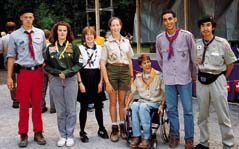
An international Scout staff is represented by the uniforms of Germany, Ireland, England, U.S.A., France, Libya, and Japan.
Text and Photographs By Marianne Gold
As the train rounded the bend, I gleaned my first view of Switzerland's Kander River Valley. The view was, in the words of my generation, "totally awesome."
I had made the 30-hour trip from my home in Warren, Ohio, to the Swiss village of Kandersteg, where I would serve for three months as a volunteer staff member at the Kandersteg International Scout Centre (KISC).
Three KISC staff members--Caroline Noser from Switzerland, Annika Fjellner from Sweden, and Helen Hailwood from England--met me at the Kandersteg rail station. They drove me the short distance to the KISC headquarters, where I was warmly greeted by Aidan Jones, the center's longtime director, and John Moffat, at the time program director and now director.
 An international Scout staff is represented by the uniforms of Germany, Ireland, England, U.S.A., France, Libya, and Japan. |
I also met other summer staffers, including Rouven Gairing from Germany, Iker Guimaraes from Spain, Rami Salem from Libya, Anna Rasimus from Finland, and Gunilla Karlsson from Sweden.
Also on hand was Matt Hanson, the other BSA representative on the KISC summer staff, with whom I had worked during my two years on staff at Philmont Scout Ranch, the BSA national high adventure base in New Mexico.
Not familiar with Swiss German, the prevailing language in the Kandersteg area, I was pleased that English was the "official" KISC language.
At 42 acres, KISC is relatively small, but it serves as a home base for treks into the surrounding area. Not surprisingly, staff training, which featured games and group activities, involved similar forays into the countryside.
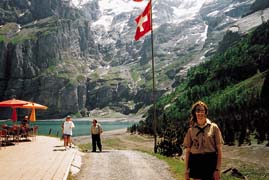 On a staff scavenger hunt, Marianne stops at Lake Oeschinensee, just a short chair lift ride from Kandersteg. |
The villagers, used to Scouting's presence, expressed no surprise when we approached them for assistance in the search. Asking for help was not easy, because no one on our team spoke German, but we tried hard and managed to communicate.
Training also included a trek to the top of a nearby mountain peak.
On the way up we stopped for the night at one of the many alpine huts used by KISC's hiking and rock-climbing groups. Evening brought song and revelry as we shared our life stories and backgrounds. This was my first international Scouting experience, and I discovered how the movement instantly bridges all boundaries of nations, customs, and creeds.
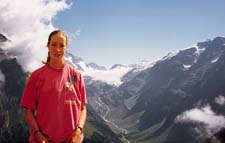 Marianne visits Zermatt, a scenic village at the foot of the Matterhorn. The railway system makes short trips easy on days off. |
The next day we reached the top, where the grandeur gave new meaning to the word "breathtaking." To the south were the Italian Alps and the tip of the legendary Matterhorn; to the west, the French Alps; to the north, the valleys and plains sweeping toward the Swiss capital of Bern; to the east, the ominous Eiger mountain and the Jungfrau, the setting for scenes of intrigue in several movies.
And way, way below (more than 6,000 feet) were the Swiss villages, valleys, streams, and brilliant meadows now viewed in miniature, almost dreamlike in appearance.
Glacier-training was next. I had never seen a glacier; and I marveled at how the snow and ice had been compressed, perhaps for a thousand years, its rugged surface now covered with gravel-laden bits of debris from water runoff.
Glacier-hiking and glacier-crossing turned out to be important skills for me, because when I received my staff assignment, it was mountain program duty. This included leading group glacier treks and also accompanying hikers to a mountain cheese factory (the "cheesery") and on sunrise treks to Galihorn Peak.
The sunrise hikes meant getting up at 2 a.m., quite a chore for a notorious late riser (me). But I soon got used to the routine, especially after seeing the enthusiasm on the faces of my first group of hikers, a crew of Irish Scouts.
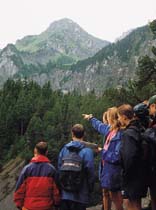 Dressed for changing weather, Marianne leads English Scouts on a mountain hike. |
Cheesery hikes were my favorite. The trail was long and steep, but at the end was a four-generation operation where we could see Swiss cheeses being made. And cheese samples were available in abundance, renewing our spent energies for the climb down.
Weather in the Swiss Alps is always unpredictable, except for rain, which is guaranteed. July can feel like midwinter one moment and, an hour later, like midsummer. Often I would be in my rainsuit one hour, shorts the next, and a heavy jacket a few hours later.
Some days would find me assisting at the 75-foot rappelling cliff. (Also known as "abseiling," rappelling is one of the more popular KISC programs.)
Some days I would "work the till," or cash register, at "the shop," or trading post.
The potpourri of nations and customs made each evening campfire a unique experience. And language never stood in the way of international Scout friendships.
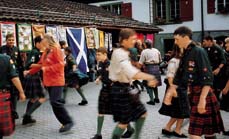 Scots demonstrate Highland dancing outside the chalet. Groups from many nations turn Kandersteg into a mini world jamboree. |
Each group of visitors brought its special contribution. Scots in their traditional kilts (a part of their Scout uniform) had us twirling with Highland dances. Texans threw a western barbecue. Staff also added to the international experience. My contribution included pancakes topped with maple syrup.
On Aug. 1, Swiss National Day, we eagerly joined in the village festivities--games, dancing, singing, and marvelous food and craft exhibits. Night brought a candlelight parade. Wearing my BSA uniform, I was proud to be one of the bearers of the Swiss national flag.
Europe's marvelous railway system makes travel easy. On my days off I was able to visit several nearby towns, such as Interlachen, a cultural mecca, and Zermatt, a scenic village located at the foot of the Matterhorn.
One staff trip took us to the city of Lucerne and its nearby attractions, and afterward Gunilla, Anna, and I undertook a three-day train excursion to Italy, stopping at Milan, Venice, and Florence.
The end of summer drew near all too quickly. Jasmia headed back to Yugoslavia, Toru left for Japan, and then Gunilla and Anna returned to their Scandinavian homes.
I went to Paris to spend some time with my sister-in-law's family, and Matt and Rami showed up for a surprise visit.
My international Scouting friendships have continued. I hear frequently from former staffers and campers by letter, phone, and e-mail.
A Kanderstag visit requires a year or two to plan as well as to give your Scouts time to earn their way. But the result, as I discovered, will be an unparalleled Scouting adventure.
Marianne Gold is a student at the University of Toledo, where she majors in outdoor recreation. She spent the summer of 1996 at Kandersteg, and last summer she served as a staff member of the Western Alaska Council's high adventure program.
Rafting to Face-Painting: Kandersteg Has Programs for EveryoneIn a typical year, more than 9,000 Scouting youth--boys and girls ranging in age from 12 to 21--from 25 different countries enjoy the year-round programs offered by the Kandersteg International Scouting Centre. Many programs are tailored both for a group or an individual. All activities should be booked in advance; many, such as rafting, are available through contract operators in the region and must be scheduled before arrival. (All activities can be scheduled through KISC's program office.) Nights in the mountains are often spent in one of KISC's alpine huts. These provide a popular respite after a long day's hike. For those who prefer a more leisurely experience, there are craft programs at KISC, including a Swiss tradition of intricate leatherwork as well as paper marbling, screen-painting, and face-painting. Many enjoy hiking around the village and its surrounding meadows. Also there are nature/environmental programs and projects presented on a daily basis. When not on the trail, campers stay either in one of KISC's many buildings or the campground. "The Chalet" accommodates 150 Scouts in 22 rooms. A large, round stone structure known as "The Tower" is the most popular night venue, accommodates 54 people, and must be scheduled long in advance. The entire campsite has room for approximately 1,200 campers. M.G. |
Kandersteg at a GlanceEstablished in 1923 by Scouting's founder, Lord Baden-Powell, Kandersteg International Scout Centre is located on 42 acres in the Swiss Alps village of the same name. It is owned by the Geneva-based World Scout Association and is managed by the British Scout Association. Staff Opportunities Through the BSA's European Camp Staff Program, up to 50 seasonal volunteer staff positions are available at Kandersteg and other Scout centers in Europe. (Local or national camp experience is generally a prerequisite.) Applications are available from the BSA International Division, 1325 W. Walnut Hill Ln., S221, P.O. Box 152079, Irving, TX 75015-2079. Attending Kandersteg
For more information
Address: Kandersteg International Scout Centre, CH-3718 Kandersteg, Switzerland |
| The Boy Scouts of America | http://www.scouting.org |